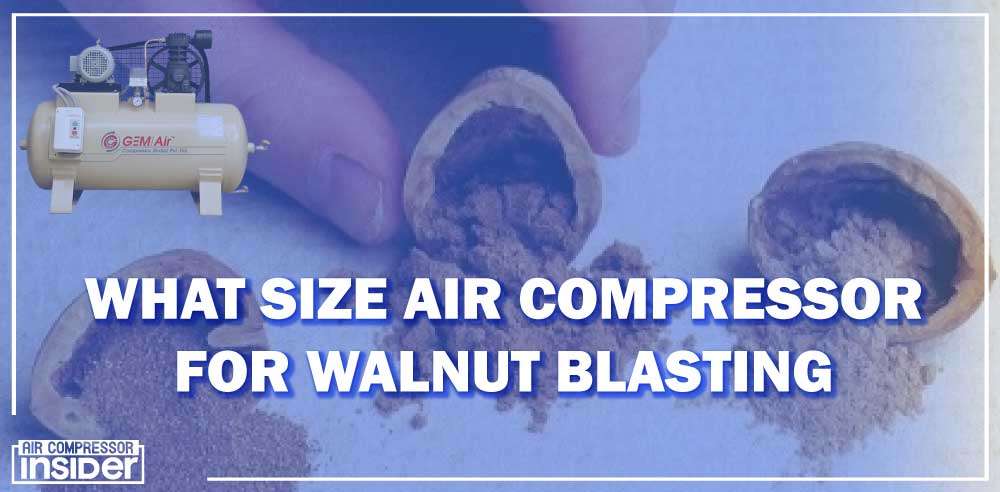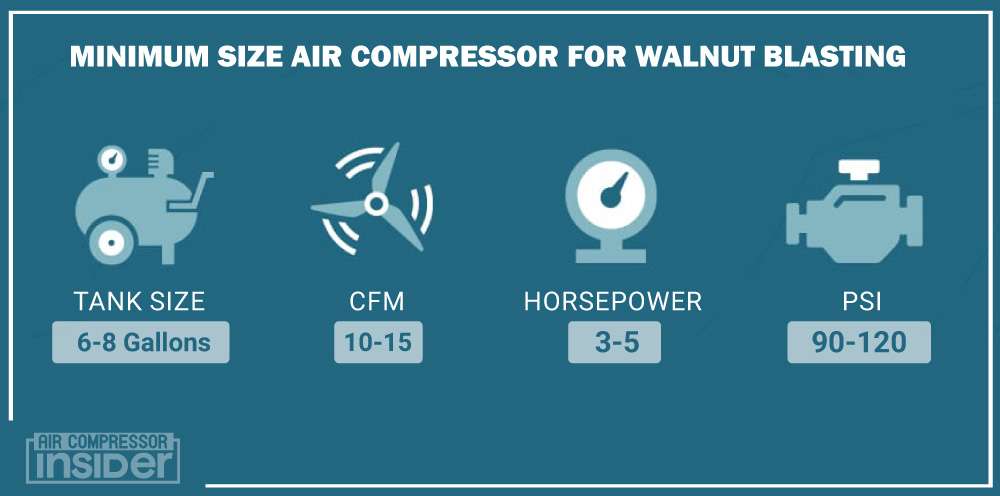Walnut blasting is a process of using crushed walnut shells to remove paint and other debris from metal surfaces. It is a popular method for restoring classic cars and motorcycles. The process can also be used to remove paint from other metal surfaces, such as boats and industrial equipment.
When it comes to walnut blasting, the size of air compressor you’ll need will depend on a few factors. The first is the size of the job – if you’re only doing a small area, you won’t need as much power as if you’re doing a larger area.
The second factor is the type of blaster you’re using. If you’re using a smaller blaster, you won’t need as much power as if you’re using a larger blaster. Finally, the third factor is the pressure you’re using. If you’re using a higher pressure, you’ll need a high pressure air compressor to be able to handle it.
What Size Air Compressor For Walnut Blasting

The best size air compressor you will need for walnut blasting depends on a few factors, such as the size of the area you need to clean and the pressure of the air compressor. For example, a small area can be cleaned with a portable air compressor that has a pressure of around 90 psi. However, if you need to clean a large area, you will need an air compressor with a higher pressure, such as a 200 psi air compressor.
To determine the size of air compressor you need for walnut blasting, you first need to determine the size of the area you need to clean. This will help you determine the CFM (cubic feet per minute) rating of the air compressor you need. For example, if you need to clean a 20 square foot area, you will need an air compressor with a CFM rating of 4.0.
For a small job, you can get away with a compressor that has a max PSI of around 90. This will be enough to power a small blaster and give you the pressure you need to get the job done.
For a medium-sized job, you’ll need a compressor with a max PSI of around 120. This will give you enough power to use a medium-sized blaster and still have the pressure you need to get the job done.
For walnut blasting, you’ll need an air compressor with a CFM rating of at least 10-15 and a PSI rating around 90-120. HP should be in the 3-5 range, and the tank size should be around 6-8 gallons or higher.

What Is Walnut Blasting?
Walnut blasting is an effective way to clean the intake valves and ports of an engine. The process removes carbon buildup from the intake valves and ports, leaving them clean. The process is quick and easy, and it does not require the removal of the intake manifold. Walnut blasting is a safe and effective way to clean the intake valves and ports of an engine. The process is quick and easy, and it does not require the removal of the intake manifold.
Also Read: What Size Air Compressor For Sandblasting
Important Factors to Consider When Selecting an Air Compressor for Walnut Blasting:

How Much PSI Is Required For Walnut Blasting?
If you’re looking to remove paint, rust, or other debris from metal surfaces, you may be wondering how much PSI is required when using an air compressor for walnut blasting. The short answer is that it depends on the compressor and the nozzle you’re using.
To get a little more specific, most air compressors will require at least 90 PSI to operate properly. However, if you’re using a smaller compressor, you may be able to get away with using less PSI. It really just depends on the specific model and make of your compressor.
As for the nozzle, you’ll want to make sure you’re using one that is specifically designed for walnut blasting. These nozzles have a wider orifice than regular nozzles, which allows for more air flow. This is important because you need a lot of air flow to remove paint, rust, or other debris from metal surfaces.
To sum it up, how much PSI is required when using an air compressor for walnut blasting depends on the compressor and nozzle you’re using. Most compressors will require at least 90 PSI to operate properly, but you may be able to get away with less if you’re using a smaller air compressor.
How Much CFM Is Required For Walnut Blasting?
When it comes to using an air compressor for walnut blasting, one of the most important things to consider is how much CFM is required. The reason for this is because the amount of CFM will directly affect the performance of the compressor and the quality of the blast.
If you have a high CFM compressor, then you can expect a more powerful blast and a higher quality finish. However, if you have a low CFM compressor, then you can expect a weaker blast and a lower quality finish.
So, how much CFM do you need when using an air compressor for walnut blasting? Well, it really depends on the application. If you are doing light blasting, then you can get away with a lower CFM compressor. However, if you are doing heavy blasting, then you will need a higher CFM compressor.
To give you an idea of what to expect, a light blast will require approximately 3-5 CFM, while a heavy blast will require approximately 10-15 CFM. Of course, these are just general guidelines and your specific application may require more or less CFM.
How Much Horse Power Is Required For Walnut Blasting?
When it comes to walnut blasting, one of the most important factors to consider is the amount of horsepower required to operate your air compressor. Depending on the size and power of your compressor, you may need anywhere from 3 to 5 horsepower to properly blast walnuts. If you’re not sure how much horsepower your compressor needs, consult the manufacturer’s specifications or a walnut blasting professional.
What Tank Size Is Required For Walnut Blasting?
When it comes to walnut blasting, one of the most important considerations is tank size. After all, you need to have enough air in the tank to power the blaster and remove all the debris. But how do you know what size tank you need?
The answer depends on a few factors, including the size of the blaster, the amount of air it uses, and the pressure you need. Here’s a look at each of these factors to help you determine the right tank size for your needs.
Blaster Size:
The size of the blaster is one of the biggest factors in determining tank size. A small blaster will use less air than a large blaster, so you’ll need a smaller tank. Conversely, a large blaster will use more air, so you’ll need a larger tank.
Air Usage:
Another factor to consider is air usage. The amount of air a blaster uses will depend on the type of blaster, the size of the nozzle, and the pressure you’re using. A high-pressure blaster will use more air than a low-pressure blaster.
As a general rule of thumb, a 6-8 gallon tank air compressor will be enough for walnut blasting.
Is Portable Air Compressor Required For Walnut Blasting?
Portable air compressors are not required when using air compressors for walnut blasting. However, many people find them to be helpful in a number of ways. For example, portable air compressors can be used to fill air tanks that are used with walnut blasting guns, this can save time and hassle when refilling tanks during a walnut blasting session.
Additionally, portable air compressors can be used to power other tools that may be needed during a walnut blasting project, such as air hoses or impact wrenches.
Also Read: What Size Air Compressor For Soda Blasting
5 Easy Steps Of Walnut Blasting With An Air Compressor:
If you’re looking to clean your car’s engine without spending a lot of money, walnut blasting with an air compressor is a great option. This process uses walnut shells to remove carbon buildup from your engine, and it’s relatively easy to do. Here’s a step-by-step guide on how to walnut blast with an air compressor.
Step 1. Start by removing the air filter from your car’s engine. This will give you better access to the engine’s intake manifold.
Step 2. Next, attach the air compressor to the intake manifold. Make sure that the compressor is properly secured so that it doesn’t come loose during the blasting process.
Step 3. Once the compressor is in place, turn it on and let it run for a few minutes. This will help to loosen any carbon buildup that’s on the intake manifold.
Step 4. Now it’s time to start blasting. Hold the air nozzle close to the intake manifold and move it around to blast the carbon buildup.
Step 5. When you’re finished blasting, turn off the compressor and replace the air filter. That’s it! You’ve now successfully cleaned your car’s engine with an air compressor.
Also Read: What Size Air Compressor For Sandblasting Cabinet
Safety Precautions to Follow When Walnut Blasting with Air Compressor:
There are several benefits of using an air compressor for walnut blasting.
First, it is a very effective way to clean your engine. The high-pressure air will remove all of the build-up and debris that can clog your engine and cause it to run less efficiently.
Second, walnut blasting is a very fast way to clean your engine. You can usually have your engine cleaned in just a few minutes using this method.
Third, walnut blasting is a very safe way to clean your engine. The high-pressure air is not harmful to your engine and will not cause any damage. Fourth, this method is also very affordable. You can find air compressors for walnut blasting at most auto parts stores.
Another benefit of using an air compressor for walnut blasting is that it can help to save time. If you’re using a traditional method of walnut blasting, such as manual scrubbing, it can take a long time to remove all of the contaminants. With an air compressor, you can quickly and easily remove all of the debris, saving you time in the long run.
Conclusion:
With the right size air compressor, you can get best performance for walnut blasting. But finding the best air compressor for walnut blasting can be tricky, but with the proper knowledge and understanding of what factors to consider, you can easily find the best air compressor for your walnut blasting needs. Make sure to take into account CFM rating, flow meter, duty cycle, portability, and any necessary accessories before selecting the right air compressor for walnut blasting.
